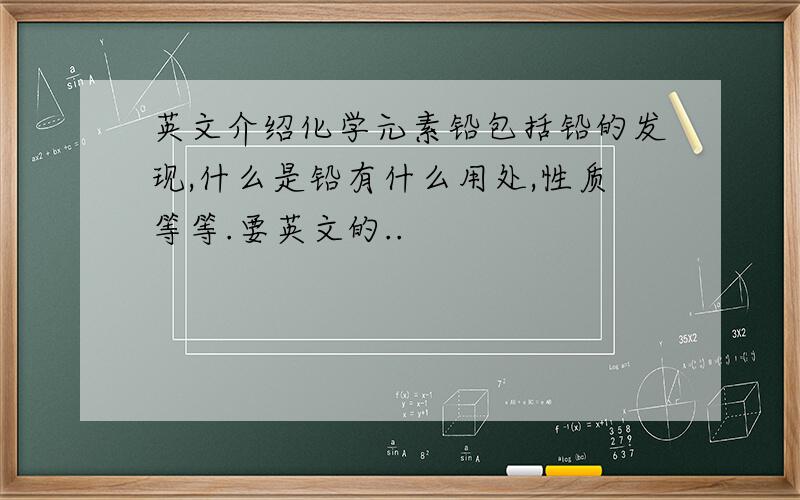英文介绍化学元素铅包括铅的发现,什么是铅有什么用处,性质等等.要英文的..
来源:学生作业帮助网 编辑:作业帮 时间:2024/04/19 06:19:22

英文介绍化学元素铅包括铅的发现,什么是铅有什么用处,性质等等.要英文的..
英文介绍化学元素铅
包括铅的发现,什么是铅
有什么用处,性质等等.要英文的..
英文介绍化学元素铅包括铅的发现,什么是铅有什么用处,性质等等.要英文的..
性质
Lead is bright and silvery when freshly cut but the surface rapidly tarnishes in air to produce the more commonly observed dull luster normally associated with lead. It is a dense, ductile, very soft, highly malleable, bluish-white metal that has poor electrical conductivity. This true metal is highly resistant to corrosion, and because of this property, it is used to contain corrosive liquids (e.g., sulfuric acid). Because lead is very malleable and resistant to corrosion it is extensively used in building construction, e.g., external coverings of roofing joints. Lead can be toughened by addition of a small amount of antimony or other metals. All lead, except 204Pb, is the end product of a complex radioactive decay. Lead is also poisonous, as are its compounds.
这段是同位素
Lead has many isotopes but 4 stable ones. The 4 stable isotopes are204Pb, 206Pb, 207Pb and 208Pb with 204Pb regarded as primordial Pb and 206, 207, 208 are formed from decay of U and Th. The one common radiogenic isotope, 202Pb, has a half-life of approximately 53,000 years.[1]
这一段是历史
Lead has been commonly used for thousands of years because it is widespread, easy to extract and easy to work with. It is highly malleable and ductile as well as easy to smelt. Metallic lead beads dating back to 6400 B.C. have been found in Çatalhöyük in modern-day Turkey.[7] In the early Bronze Age, lead was used with antimony and arsenic. Lead is mentioned in the Book of Exodus (15:10).
In alchemy, lead was thought to be the oldest metal and was associated with the planet Saturn. Lead pipes that bear the insignia of Roman emperors are still in service[citation needed] and many Roman "pigs" (ingots) of lead figure in Derbyshire lead mining history and in the history of the industry in other English centers. The Romans also used lead in molten form to secure iron pins that held together large limestone blocks in certain monumental buildings. Lead's symbol Pb is an abbreviation of its Latin name plumbum for soft metals; originally it was plumbum nigrum (literally, "black plumbum"), where plumbum candidum (literally, "bright plumbum") was tin. The English words "plumbing", "plumber", "plumb", and "plumb-bob" also derive from this Latin root.
生产和回收
Production and recycling
Production and consumption of lead is increasing worldwide. Total annual production is about 8 million tonnes; about half is produced from recycled scrap. The top lead producing countries, as of 2008, are Australia, China, USA, Peru, Canada, Mexico, Sweden, Morocco, South Africa and North Korea.[10] Australia, China and the United States account for more than half of primary production.[11]
2008 mine production: 3,886,000 tonnes
2008 metal production: 8,725,000 tonnes
2008 metal consumption: 8,706,000 tonnes[12]
At current use rates, the supply of lead is estimated to run out in 42 years.[13] Environmental analyst, Lester Brown, however, has suggested lead could run out within 18 years based on an extrapolation of 2% growth per year.[14] This may need to be reviewed to take account of renewed interest in recycling, and rapid progress in fuel cell technology.
这段是实际应用
Lead is a major constituent of the lead-acid battery used extensively as a car battery.[15]
Lead is used as a coloring element in ceramic glazes, notably in the colors red and yellow.[16]
Lead is used to form glazing bars for stained glass or other multi-lit windows. The practice has become less common, not for danger but for stylistic reasons.
Lead is frequently used in polyvinyl chloride (PVC) plastic, which coats electrical cords.[17][18]
Lead is used as projectiles for firearms and fishing sinkers because of its density, low cost compared to alternative products and ease of use due to relatively low melting point.[19]
Lead, or sheet-lead, is used as a sound deadening layer in such areas as wall, floor and ceiling design in sound studios where levels of airborne and mechanically produced sound are targeted for reduction or virtual elimination.[20][21]
Lead is used in some candles to treat the wick to ensure a longer, more even burn. Because of the dangers, European and North American manufacturers use more expensive alternatives such as zinc.[22][23]
Lead is used as shielding from radiation (e.g., in X-ray rooms).[24]
Molten lead is used as a coolant (e.g., for lead cooled fast reactors).[25]
Lead glass is composed of 12-28% lead oxide. It changes the optical characteristics of the glass and reduces the transmission of radiation.[26]
Lead is the traditional base metal of organ pipes, mixed with varying amounts of tin to control the tone of the pipe.[27][28]
Lead is used as electrodes in the process of electrolysis.
Lead is used in solder for electronics, although this usage is being phased out by some countries to reduce the amount of environmentally unfriendly waste.
Lead is used in high voltage power cables as sheathing material to prevent water diffusion into insulation.
Lead is added to brass to reduce machine tool wear.
Some artists using oil-based paints continue to use lead carbonate white, citing its properties in comparison with the alternatives.
Lead, in the form of strips, or tape, is used for the customization of tennis rackets. Tennis rackets of the past sometimes had lead added to them by the manufacturer to increase weight.[29]
Lead has many uses in the construction industry (e.g., lead sheets are used as architectural metals in roofing material, cladding, flashings, gutters and gutter joints, and on roof parapets). Detailed lead moldings are used as decorative motifs used to fix lead sheet.
Lead is still widely used in statues and sculptures.
Tetra-ethyl lead is used as an anti-knock additive for aviation fuel in piston driven aircraft.
Lead-based semiconductors, such as lead telluride, lead selenide and lead antimonide are finding applications in photovoltaic (solar energy) cells and infrared detectors.[30]
Lead is often used to balance the wheels of a car; this use is being phased out in favor of other materials for environmental reasons.